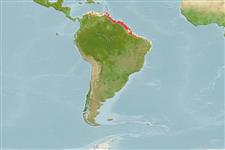Environment: milieu / climate zone / Tiefenbereich / distribution range
Ökologie
seewasser; süßwasser; brackwasser demersal. Tropical; 13°N - 11°S, 77°W - 35°W
Western Atlantic: Caribbean and Atlantic draining rivers and estuaries from Colombia to Brazil.
Length at first maturity / Size / Gewicht / Alter
Geschlechtsreife: Lm 36.6 range ? - 44.7 cm
Max length : 100.0 cm TL Männchen/unbestimmt; (Ref. 3265); common length : 50.0 cm TL Männchen/unbestimmt; (Ref. 3265); max. veröff. Gewicht: 9.0 kg (Ref. 5217); max. veröff. Alter: 4 Jahre (Ref. 51629)
Rückenflossenstacheln (insgesamt) : 1. The head is more or less flattened, the nostril nearly rounded, mouth inferior. There are three pairs of barbels, 1 pair of maxillary barbel and 2 pairs of mandibular barbels.
Body shape (shape guide): elongated.
Inhabits mainly brackish estuaries and lagoons. Occurs also in freshwaters (Ref. 58022). Found on shallow muddy bottoms (Ref. 5217). Feeds on fish and shrimps. Two annual cycles of slower growth occur during the dry seasons (March and August to November). Life span is three to four years. Sexually mature at 1.5 to 2 years of age. Reproduction takes place from November to April. Consumed as food (Ref. 35381). Marketed fresh. The skull is sold throughout the world as crucifix.
Pairing involved in reproduction. Mouth brooding may be employed (Ref. 205).
Taylor, W.R. and N.A. Menezes, 1978. Ariidae. In W. Fischer (ed.) FAO species identification sheets for fishery purposes. West Atlantic (Fishing Area 31). volume 1. [pag. var.]. FAO, Rome. (Ref. 3265)
IUCN Rote Liste Status (Ref. 130435: Version 2025-1)
Bedrohung für Menschen
Traumatogenic (Ref. 36613)
Nutzung durch Menschen
Fischereien: kommerziell
Tools
Zusatzinformationen
Download XML
Internet Quellen
Estimates based on models
Preferred temperature (Ref.
123201): 26.9 - 27.8, mean 27.4 °C (based on 66 cells).
Phylogenetic diversity index (Ref.
82804): PD
50 = 0.5078 [Uniqueness, from 0.5 = low to 2.0 = high].
Bayesian length-weight: a=0.00617 (0.00377 - 0.01008), b=3.17 (3.02 - 3.32), in cm total length, based on LWR estimates for this species & (Sub)family-body (Ref.
93245).
Trophic level (Ref.
69278): 4.4 ±0.7 se; based on diet studies.
Widerstandsfähigkeit (Ref.
120179): hoch, Verdopplung der Population dauert weniger als 15 Monate. (tm=1.5; tmax=3.5; K=0.5).
Prior r = 0.98, 95% CL = 0.65 - 1.47, Based on 3 data-limited stock assessments.
Fishing Vulnerability (Ref.
59153): High vulnerability (60 of 100).
🛈
Nutrients (Ref.
124155): Calcium = 98.3 [51.2, 205.4] mg/100g; Iron = 1.09 [0.68, 1.92] mg/100g; Protein = 17.3 [15.6, 19.0] %; Omega3 = 0.169 [0.095, 0.304] g/100g; Selenium = 68.5 [33.7, 141.9] μg/100g; VitaminA = 16.1 [6.8, 40.8] μg/100g; Zinc = 0.811 [0.533, 1.257] mg/100g (wet weight);
